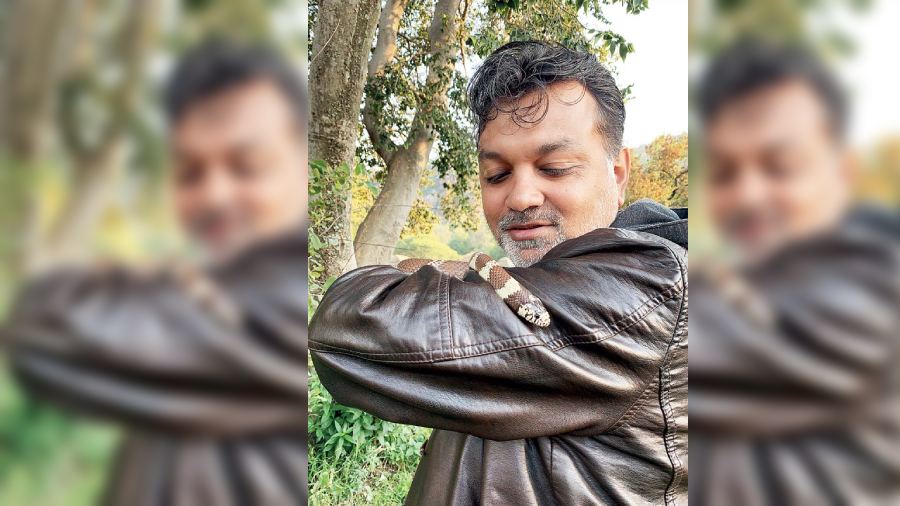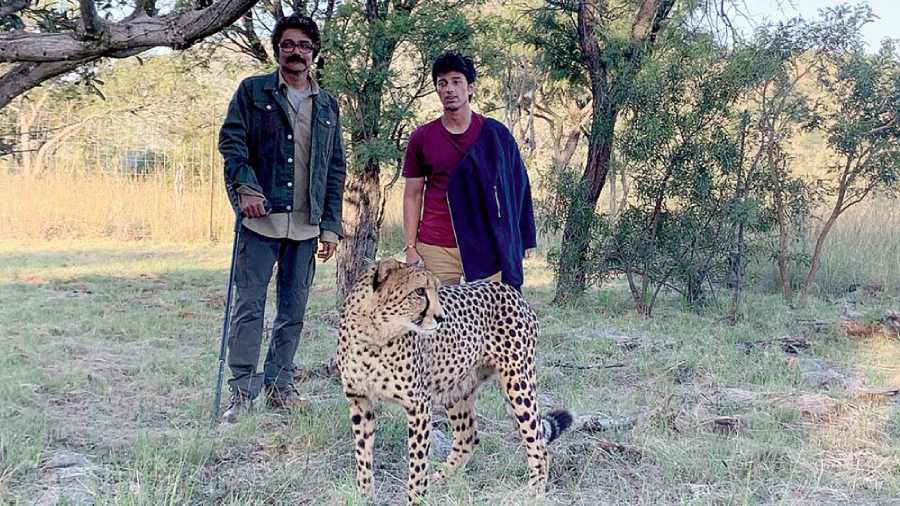Shooting in Egypt for the film Mishawr Rawhoshyo was an adventure by itself. “There was curfew, people were dying in police firing… we used to hear all this when we were back in the hotel. There used to be a lot of agitation in the hotel because of that. There was a constant presence of the tourism police and the military while the shoot was going on, it was very closely monitored. Shooting was stalled on a couple of occasions…. Then we shot the camel chase sequence, that was like 26km inside Sahara Desert. There was no one, it was absolutely barren, no communication, no civilisation. We got surrounded by the Bedouin mafia there, who were carrying light machine guns… we just escaped, barely,” director Srijit Mukherji had told The Telegraph in 2013.
Kakababur Protyaborton, which releases in Bengali and Hindi today, amps up the adventure quotient as it is extensively shot in the jungles of Africa in the Maasai Mara National Reserve. A Telegraph chat with Srijit...
Kenya, with its spectacular wildlife and vibrant culture, is full of fascinating experiences. Growing up, did you have dreams of going on treks that allowed you to take a peek into secrets of the jungles?
Absolutely. We grew up watching films like African Safari and Hatari. My growing up years were interspersed with trips to jungles of Kanha and Simlipal.
Were those boyhood dreams fulfiled this time?
It was a dream come true. We were not only shooting in the wild but staying in the wild in the middle of the savannah in exactly the kind of hotel that is described in the book... amidst all the animals.
Both our shooting experiences in Kenya and South Africa were fascinating and incredible.
What was your first impression of the place when you landed there?
The type of jungle is very different. It is not the very green, thick, dense foliage jungle, or the slightly drier yellowish brown jungles of India. This one was more of grasslands... grass of various heights. There are trees but it is a different kind of a landscape. The flora and fauna are so different... the kind of deer, big cats. That was the first thing that struck me. As we went inside the jungles more and more, this difference started manifesting itself in mind-boggling variety of animals all around.
How would you describe Maasai Mara? Is it a place for thrills and calm?
Both, I guess. Maasai Mara has an incredible calm about it. A very peaceful Zen-kind of an ambience about it. And yet you know from the occasional sounds of animals, the actual sightings, that danger lurks at every corner. Therein lies the thrill of Maasai Mara. It is fascinating, the best of both worlds. The relaxing, calming ambience and also something that keeps you on the edge with its thrill.
Did you follow the text closely this time or make necessary changes and upgrade it?
This time, yes, it was kind of a mixed approach of Mishawr Rawhoshyo and Yeti Obhijaan. I have not followed the text as loyally as I did in Yeti Obhijaan because it had its own backlash. I have made cinematic adaptations and changes. The changes make it more exciting, engaging and interesting. There are layers which I have added to the story to give it certain elements which I thought will appeal to the audience.
Why pick this particular Kakababu story? Did you feel the need for a story that would enable you to add another layer?
I always wanted to do a trilogy, so after the desert and mountain next in line was obviously the jungle.... there are many Kakababu stories set in jungles but this one is the most exotic, exciting and international. That has always been the mandate for Kakababu. It has to be an international adventure. Which is why this story. And I do have a natural bias for the jungle.
In 2013, you had said that there’s this kind of a holy cow syndrome in Bengal, which forbids one to reinterpret or take a re-look at classic characters in contemporary times. Is the situation still the same?
Things are much better than before. Extreme or radical interpretation is frowned upon. People definitely have understood there is a difference between a story book and a film narrative. Things are slightly easier now.

I love snakes, and for the longest time I have been planning to keep one as a pet. Trying to find out how we could do it legally. So I was playing with the snake brought by the handler and it was going all over me — Srijit
What were the challenges you faced when directing this film?
The resource crunch and the ridiculous number of days we had to shoot this humongous film with its great scale. We had only 11 days to shoot the film in Kenya and South Africa. Shooting with animals was so unpredictable, you don’t know how they react on a particular day... given everything that was the greatest constraint. We kind of pulled it off thanks to a lot of patience, perseverance and planning.
How was your experience directing Prosenjit for this film?
Bumbada has aged like fine wine, he gets better and better. In this one he is absolutely on top of his game as Kakababu. He has absolutely nailed the character. There were certain shooting experiences with animals which were dangerous for him, especially the ones with wild elephant, rhinoceros and snake.
The news of lockdowns and Covid-19 started spreading while you were on shoot. Did it impact the shooting schedule? Did it force you to make changes?
No, when we were shooting we did not feel the impact of Covid. We were hearing snatches of random reports. It was absolutely normal where we were shooting. When we were coming back, it spread like wildfire. The day we returned it was a panicky situation all around and immediately I think we went into lockdown.
You shared a picture recently from the shoot with a snake around you. What’s the story behind that picture?
I love snakes, and for the longest time I have been planning to keep one as a pet. Trying to find out how we could do it legally. So I was playing with the snake brought by the handler and it was going all over me.
When it comes to directing a franchise film like Kakababu, how do you keep it fresh, exciting and inventive every time?
By choosing the most varied stories which the Kakababu franchise has to offer. For this trilogy the setting is so varied. Certain amount of versatility comes through in the stories. With each story you can add elements, elements which could be contemporary like Mishawr... and the politics of Egypt at that point of time. Or it could be structural narrative elements added to Jongoler Modhye Ek Hotel to make it more enjoyable and exciting.
What is your takeaway from the three Kakababu films?
It has been about revisiting my own childhood and reliving my childhood through these films. These films were all made for children. Kakababur Protyaborton is dedicated to my daughter Ayra and every child like Ayra who has grown up reading Chander Pahar and watching The Lion King. It is like going back in time and reliving childhood through storytelling in the grandest possible manner and scale.
